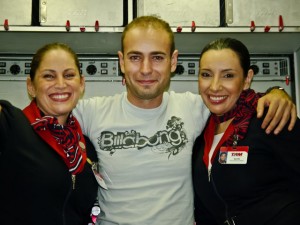 When I was just a handful of years old, my uncle had an old Canon SLR camera which he babied throughout his life. He wasn’t a professional photographer, nor did he have a clue when it came to capturing stills. Nine out of ten photos were out of focus and badly framed, but no one knew any better. His camera was pretty much the only camera in the family, so my entire childhood turned out blurry and out of frame. Oh and if we ever touched that old dinosaur. Our only chance to examine the fine equipment was when he went to work. My cousin and I used to sneak in to take the camera out of its leather case, and touch the shutter release so carefully so not to snap a picture accidentally and get in trouble. I always wanted a camera like that, but all I could have was an ancient and broken black and white camera which used 126 roll films that were so old you could not even find them in museums anymore.
When I was just a handful of years old, my uncle had an old Canon SLR camera which he babied throughout his life. He wasn’t a professional photographer, nor did he have a clue when it came to capturing stills. Nine out of ten photos were out of focus and badly framed, but no one knew any better. His camera was pretty much the only camera in the family, so my entire childhood turned out blurry and out of frame. Oh and if we ever touched that old dinosaur. Our only chance to examine the fine equipment was when he went to work. My cousin and I used to sneak in to take the camera out of its leather case, and touch the shutter release so carefully so not to snap a picture accidentally and get in trouble. I always wanted a camera like that, but all I could have was an ancient and broken black and white camera which used 126 roll films that were so old you could not even find them in museums anymore.
When Thomas Edison invented the first motion-picture camera, he fully understood what a breakthrough that was, but with today’s technology, we get to see a series of seamless stills at 30 frame per second and we take it for granted. When I first learned the physics of the motion picture I was very much interested in finding out more for myself. But again those days a professional film camera was more than a few years salary of a decent job. It took a long time for me to transition from stills to motion pictures, but when I did I never looked back. To me, a still picture only tells one fraction of a second of the story, but one second of video tells 24 to 30 times more of the same situation. I still love to take still pictures but I don’t get all hyped-up about a photograph the way I drool over a good video footage.
There are some professions in the world that don’t require the best tools of the trade. For example it would make no difference if Shakespeare wrote his entire collection with a broken goose feather or a Parker ballpoint pen; the result would have been the same. But if James Cameron shot Titanic with a cell-phone camera it would have been disastrous. He knew better. 200 million dollars later Titanic received 14 Oscar nominations; eventually sacking 11 of them. Titanic became the highest-grossing film ever made until Avatar came along in 2009. And that was his own film too. James Cameron was a school drop-out who drove trucks, and he had to take his first rental camera apart so he could figure out how to actually use it. It’s true that in most cases tools don’t make the artist, but in videography it plays a tremendous role.
From my early days of sneaking my uncle’s camera out for inspection, I knew that I had a good eye for pointing out the mistakes of others (and I arrogantly seldom acknowledged the good parts), so I became a critic. And like every critic, I was like eunuchs in a harem; I knew how it was done, I had seen it done every day, but I never did it myself. I arguably have seen more films that most. At times I watch five films a day. I watch them from credit to credit. I want to know the name of the soundman, the carpenter and even the location of the stock archive footage they used in the said film. I can tell instantly if a scene was badly shot, or edited by a crappy editor. I can point out the slightest awkward scene blocking that was not intentional, sound bites that start too early or music that fades too late. In a sense, I hardly enjoy movies anymore because I’m constantly thinking of what could make it better. It has got to have one hell of a story or a superb cinematography to watch it again. So sitting out of the ring and trying to judge the punch was getting old. I picked up a camera and started shooting.
When I set out on my mission, I honestly didn’t know how to get the attention of the audience to make them “aware” of the real poverty issues, and if I ever succeeded, it wasn’t because I was good at it. I followed the notion of persistence. I kept doing it until I got it somewhat right. I figured that if you leave a monkey with a typewriter long enough, he’ll eventually write Hamlet. I didn’t come close to writing Hamlet but I learned how to push the keys.
There’s no better exercise that doing the deed itself and filming is no exclusion. I could go to a film school but I chose a better way. I traveled with a man who understood videography better than anyone I could hope for, and by videography I don’t mean dollying an IMAX camera on tracks on a set, I mean guerrilla-style filming at its finest. Claudio von Planta spent a better half of his life in conflict zones and jungles around the world filming what made him tick; from Mujahedin struggles against the Soviets in Afghanistan to freedom seeking rebels of New Guinea fighting against Indonesian army. As I traveled with Claudio, I took notes every time he picked up the camera, from the way he positioned himself for the shot, from getting up-close and personal, from being a shadow on every move and from his absolute persistence on getting the best shot and not settling for an easy one. He became oblivious of his surrounding once the tally light came on. He climbed hills, hung from trees, walked in the middle of protests and he never got his eyes off of his subjects for anything. Honestly I can barely remember him when he didn’t have a camera in his hand. For 15 hours a day, and for over 100 days, I was in a company of a few professionals who took their work seriously, and I learned little by little the things they don’t teach you in schools. For the rest, I read as many books as I could find on films, from its history to odd ball techniques for arctic photography just In case I found myself filming ‘The March of the Penguins’ one day.
As Claudio shot his BBC series, I shot the same scenes, one from his angle and one from another perspective and compared my work to his for feedback. I shot over 90 hours of footage and I remember Claudio asking me what I was going to do with them. I didn’t have an answer for him then, but I knew what I could not do with them. They were shot on a crappy handheld camcorder with such mediocre image quality that I wouldn’t even consider it good enough for projection to a group of retarded monkeys. They were mostly mediocre B-rolls since I wasn’t filming anything in particular. But I knew they were good works in style considering I had no tripod, no light, no microphone to speak of and the camera didn’t work half the times.
My mistake was not getting the best tool for the job before I even started my journey, but again I didn’t know 100% how I was going to make people aware of world hunger. I had a vague idea but it was just an idea. I researched every possible camera for almost two years, spending hours at time reading pros and cons of each system for certain situations, but I could never find the “perfect” camera for my traveling style. I simply wanted a camera to match my limited space and unpredictable environment. There was no such a camera in existence. I wanted the system to have interchangeable lenses, shoot well in low light, have excellent image quality, full manual controls over every aspect, and preposterously I wanted it to be light, packable and in my budget too. Two years of agonizing research returned absolutely nothing until I had to alter my traveling style and budget to match my shooting needs. I finally got to a conclusion that if I was serious about videography, I couldn’t put a price or limitation on the equipment I needed. What exactly Claudio told me over and over during our conversations. I lost precious opportunities when I didn’t have the right equipment, but I was on the right track at last.
I settled for the best camera I could possibly budget for by cutting my two meals a day to one ration. I also planned on selling my DSLR camera and put the cash towards the video equipment. (At the end I kept the DSLR as I knew I would regret selling it later.) The new camera weighed a whopping 10lbs with no accessories. It was a shoulder-mount, and I could be spotted from a mile away as a Yankee, but that’s what would do the job for my meticulous taste. The whole package including professional audio equipment, tripod, lenses and storage drives was so heavy and expensive that I couldn’t get myself to ship it to South America trusting the postal service. Even if I managed to get all those goodies shipped to where I was, the customs would kill me on importation taxes the same way they killed me in Argentina when I was getting the motorcycle engine out. So I had to make an out of schedule trip to go shopping in the United States and bring the equipment back personally. I left my belongings behind in South America and hitched a free flight out of Asunción, Paraguay to São Paulo, Brazil sitting in the back with the flight attendants and keeping them company. It was a great ride, with unrestricted access to peanut bags and beer. It goes to tell again that it’s not what you know; it’s who you’re sleeping with.
My plane landed in the enormous city of São Paulo a little after midnight, and I hitched another free ride to New York City a few hours later. TAM Airlines only fly to Florida and New York and I picked the Big Apple since I had a few friends around and I wanted a change of weather from the hot tropical South. I had no time to waste so I started my shopping frenzy the second I landed, and walked the Time Square to B&H photo, a sprawling photo and electronics emporium on the 9th Ave. After a couple of hours of being mesmerized by the American life after a long time of being off-the-grids I wanted to buy everything. I shoved giant New York pizza slices down my throat as I walked from one store to another to find what I wanted. When I was done going crazy in NYC, I hopped on a Greyhound to Boston, MA where my friend Jared Williams would pick me up.
It was nice to be back in the country even for a short time. A few times I ordered my food in Spanish by default, but I got used to speaking English full-time again. The downside was that I could understand everything that everyone said, and that was a lot of useless information to take in. As I kicked back with Jared fixing up his new Suzuki GS850 motorcycle and using the super-sonic internet connections of the Northern Hemisphere, the UPS guy kept on bringing boxes after boxes until I was penniless. I made a side-trip to New Hampshire to see one of my old friends, and before I knew it I had to get back. I had to take all these electronics back with me to South America, and most importantly I had to fit them somehow on the bike safely. The GS850 is like a freight train so I wasn’t too worried about the weight, but I had to make sure that they would stay dry and safe while riding.
Jared and I spent days looking for a suitable box to fit everything in, from Pelican boxes to even amplifier hard-cases, but we couldn’t find anything that would reasonably work. The Pelican boxes were tough and waterproof, but they weighed almost 30lbs empty and they were monstrous, not mentioning the steep $300 price tag either. So we improvised. We bought a semi-hard duffel bag from Marshall’s for 30 bucks, and made our own waterproof/shockproof case, making Jared’s living room a big mess once again. It had to be big, strong and absolutely waterproof and we accomplished that. When we were done with it, I could fit the video camera and two lenses, my big laptop, my DSLR camera and two lenses, jumble of audio cables, batteries, hard drives, light, microphone and a small pillow inside with ease and nothing moved an inch from their position.
As much fun America was, it was time to go. When Jared dropped me off at the bus station in Boston, I was loaded with two suitcases, a backpack and a giant camera in my hand. From Port Authority I chased the airport bus for 300 yards and I spent the next 6 days dragging this stuff behind me because everything that could go wrong did. As I touched down in Brazil, I was arrested. I had no visa for Brazil which wasn’t a problem as long as I was in transit and stayed inside the airport, but my Paraguayan visa turned out to be a single entry visa rather than multiple entry which I thoughts it was. Automatically my ticket was canceled, and I was scheduled to be deported back to US at 6 am the next day. No amount of begging in my nonexistent Portuguese made them sway so I played their game. The “law” was to have a valid ticket and valid visa to be considered a transit passenger, so I bought a valid ticket for a country that didn’t need a visa only three hours away rather than going half the planet back to United States again. For the 7th times in a row in five months I entered Argentina. They should make me an honorary citizen; I’ve never been to any other country that many times.
And the timing couldn’t be worst. That week was the Holy Week; the Easter weekend. South Americans take their religion way too seriously so the whole country was shutdown from Thursday until next Monday when I could get another visa in Buenos Aires for Paraguay. A good thing about Argentina was that it was relatively close to where I was going, and the food is exquisite. Specially the chorizos (sausages). So I indulged in a perfect weather in the capital of Argentina for 5 days, taking my time to see my friends and enjoying the Paris of South America. I had a royal welcome even without a notice, and I was taken care of as well as I could wish for. Finally on Monday, I managed to get another visa and took a bus from Buenos Aires to Asunción, Paraguay for another 22 hours to be reunited with my bike. I miss Argentina already. I could call that place home in a heartbeat.
The whole point of this excursion was to get the right tool for the job and I finally did. But I had some homework to do. If my limit was the camera before, now I was the limit for this camera. With a gazillion manual buttons and settings to mess with, it’s a not a point and shoot camera and it takes a skilled operator to produce a good image. I knew I could shoot half decent in available light, but the hard part was recording good footage in low-light and run-and-gun situations, trying to focus and set the exposure manually at the same time. I have an excellent 3X wide angle lens which is perfect for these situations, but as my luck would have it the back focus was faulty, and I had to send it off to be fixed. So to make the best out of it in the meanwhile, flashing my press-card I attended every night-event in the city, from concerts to parades and plays. And since it’s the 200 year anniversary of independence in Paraguay, there’s no shortage of entertaining events for another month. I kept on rolling films until I mastered the lowlight manual focusing, gain and proper exposure and got to know my machine as best as possible. To this day, I have not used this camera in automatic mode and I probably never will.
I’m shooting a Docu-Film (It has no boring interviews with the characteristic of a feature film) on “Over Population”, with its effects on economy, religion and poverty, combine with the adventure of motorcycling through the jungles. It is witty, shocking, truthful and chiefly entertaining [remember that I’m a critic, so if I say it’s good; it must be:)]. In a world where I can’t get the attention of people with anything else, the motion picture stands head and a shoulder above any tool I could use. If you have made it this far down this post, you are a rare breed, not many read for that long any more. My hat is off to you.
Stay tuned.
P.S. I was turned down on my first book proposal. Bastards. Who wants to read a random chapter and give me some feedback?
P.P.S I entered Argentina for the 8th time yesterday again. I had to renew the motorcycle papers. I can’t get enough of that country.

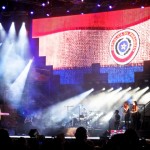
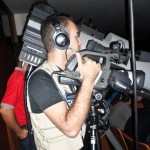
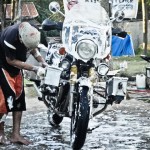
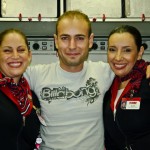


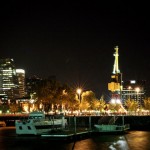
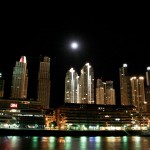
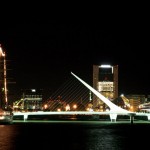


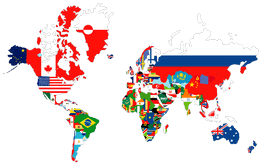
Glad your back!
Can I just say I think it’s amusing that you’re on a world wide trip for hunger… and then went to a Miley Cyrus concert.
I hope you can finally get going on your trip again!
Welcome back, Chris. It’s been a while. This sounds like the next significant stage of your journey and your work. I had no idea you were planning to make a documentary, and that camera looks pretty dang serious to me. May it go well.
Matthew,
Thanks buddy, It’ll be a long and hard job but it’s challenging nevertheless. In the past two years i started to see the impacts of a well shot film rather than a book or 100 lectures. The hope is to reach as many people as possible and combine the adventure with the message that no one wants to hear.
Julia,
You couldn’t pay me enough to stand two hours in a place and listen to bunch of screaming 14 year old girls. My friend took that picture for me, i was elsewhere that night. The reason that I’m filming these events is to have a contrast of different lives for the film.
But out of curiosity, what’s wrong with going to a concert regardless of what I am doing? You’re a Peace Corp volunteer so with that logic you’ll never go to a carnival? Your free time is yours to do anything you want with it and no one questions that.
Hey! Send me a chapter of that book, I’d be happy to critique it!
salam omid jan chetori halet khobe khosh migzare jibet por poole damaghet chaghe !!! omidvaram ke az har nazar ok bashi .
dokhtar koochooloom be donia oomad kheili naze kheili doosesh daram hamash gerye mikone hanooz barash esm nagozashtam shaiad bezaram farnaz ya mahdis ya mehrsa.
behar hal omidvaram movafagh bashi va raheto peida koni.
be omide didar